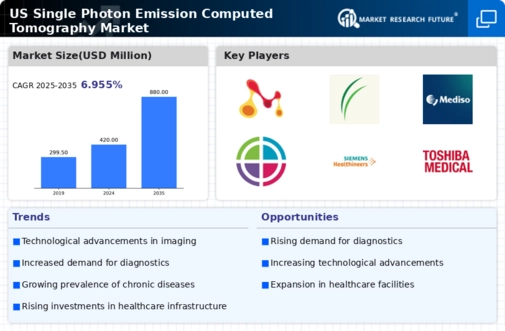Growing Geriatric Population
The increasing geriatric population in the US is a significant factor driving the single photon-emission-computed-tomography market. As individuals age, they are more susceptible to various health issues, including neurological disorders and cardiovascular diseases, which require advanced imaging for diagnosis and management. The US Census Bureau projects that by 2030, approximately 20% of the population will be aged 65 and older. This demographic shift is likely to escalate the demand for diagnostic imaging services, including single photon-emission-computed-tomography, as healthcare providers strive to cater to the unique needs of older patients.
Rising Healthcare Expenditure
The upward trend in healthcare expenditure in the US is contributing to the growth of the single photon-emission-computed-tomography market. With healthcare spending projected to reach $6 trillion by 2027, there is a corresponding increase in investment in advanced diagnostic technologies. This financial commitment enables healthcare facilities to acquire state-of-the-art imaging equipment, including single photon-emission-computed-tomography systems. As hospitals and clinics allocate more resources towards enhancing diagnostic capabilities, the market is likely to experience robust growth, driven by the demand for high-quality imaging solutions.
Enhanced Focus on Preventive Healthcare
There is a growing emphasis on preventive healthcare in the US, which is positively impacting the single photon-emission-computed-tomography market. As healthcare providers and patients alike recognize the importance of early detection and intervention, the demand for advanced imaging techniques is increasing. Single photon-emission-computed-tomography plays a crucial role in screening and monitoring various health conditions, thereby aligning with the preventive healthcare paradigm. This shift towards proactive health management is expected to drive market growth, as more individuals seek out diagnostic imaging services to identify potential health issues before they escalate.
Increasing Prevalence of Chronic Diseases
The rising incidence of chronic diseases such as cardiovascular disorders and cancer in the US is a primary driver for the single photon-emission-computed-tomography market. As these conditions become more prevalent, the demand for advanced diagnostic imaging techniques increases. According to recent statistics, chronic diseases account for approximately 70% of all deaths in the US, necessitating effective diagnostic tools. Single photon-emission-computed-tomography offers precise imaging capabilities that aid in early detection and treatment planning. This growing need for accurate diagnostics is likely to propel the market forward, as healthcare providers seek to enhance patient outcomes through advanced imaging technologies.
Technological Innovations in Imaging Techniques
Technological advancements in imaging modalities are significantly influencing the single photon-emission-computed-tomography market. Innovations such as improved detector technologies, enhanced image reconstruction algorithms, and the integration of artificial intelligence are transforming the landscape of diagnostic imaging. These advancements not only improve image quality but also reduce scan times, making procedures more efficient. The market is projected to witness a growth rate of around 8% annually, driven by these innovations. As healthcare facilities adopt cutting-edge technologies, the demand for single photon-emission-computed-tomography systems is expected to rise, reflecting a shift towards more sophisticated diagnostic solutions.

















Leave a Comment